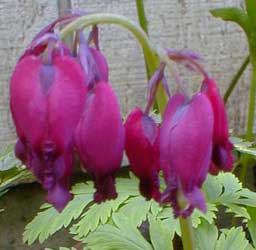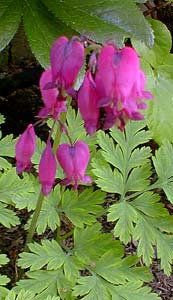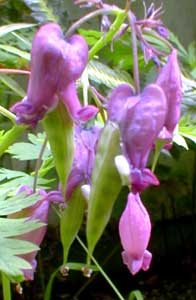
Western Bleeding Heart
"This is the red, red region
Your heart must journey through
Your pains will here be legion
And joy be death for you."
-George William Russell
(1867-1935)
(1867-1935)
Pacific Bleeding Heart, aka Wild Bleeding Heart, aka Western Bleeding Heart (Dicentra formosa) exceeds the Eastern Bleeding Heart (D. eximia) for floweriness & dramatic impact, though both are extremely lovely shade perennials.
 This one is native of our very own Pacific Northwest's moist & shady woodland areas, but also seen alongside roads' drainage ditches in fuller sun. So it does spectacularly well in a Puget Sound gardens, since it effectively hasn't left its natural home.
This one is native of our very own Pacific Northwest's moist & shady woodland areas, but also seen alongside roads' drainage ditches in fuller sun. So it does spectacularly well in a Puget Sound gardens, since it effectively hasn't left its natural home.It self-seeds vigorously, & produces seeds throughout its long bloom period. The third photo snapped in May shows the pink flowers turning into comparatively enormous seed-fruits. These pop open & distribute seeds some distance. Seedlings can bloom their first year. Extra seedlings can be dug up & potted to be given to friends for their gardens.
 We've had them appear so far distant from where we planted specimens that we cannot assume they weren't seeded from a neighbors' gardens or nearby meadows. Specific cultivars generally need to be cultivated by division to be true-to-form, but if seedlings revert to the wildflower, they will still be dandy garden plants.
We've had them appear so far distant from where we planted specimens that we cannot assume they weren't seeded from a neighbors' gardens or nearby meadows. Specific cultivars generally need to be cultivated by division to be true-to-form, but if seedlings revert to the wildflower, they will still be dandy garden plants.It forms a smallish clump a foot & a half by two feet, but if permitted to do so can colonize by rhizomes as well as by self-seeding to any width desired. Not that it is invasive, as it's too easily pulled up from any spot where it is not wanted, & can never be regarded as a burden. The volunteers we've permitted in our garden have needed at least moderate babying to get started, as the young plants do not out-compete established perennials.
In our garden, the ferny blue-green leaves barely emerge in March (a month ahead of E. eximia) & are getting very lush by early April, blooming even before the leaves are at their maximum. The two photos on this page were snapped a week or two apart in April, showing the first blossoms of the year. There are leaves of a yellow hellebore intruding into the second photo.
There is considerable color variation, with most being in the pink range, but ours is the deepest possible rose-magenta. Though ours was bought as a seedling from a native plants specialist as the wild form, it is in reality so much darker colored than the wild pinks that I'm fairly certain it is the cultivated 'Bacchanal' & was not sold as such merely because of the unpredictability of seed-grown cultivars.
D. formosa does not go dormant in summer just so long as it never fully dries out. It blooms the entirety of spring; continues to bloom (if a little less extravagantly) through summer; then will have another mass of blooms in autumn before slowly dying back for winter. Granny Artemis & I have quite a number of corydalis & dicentra species throughout our gardens, & while it is difficult to choose favorites, 'Bacchanal' is certainly one of highest favor.